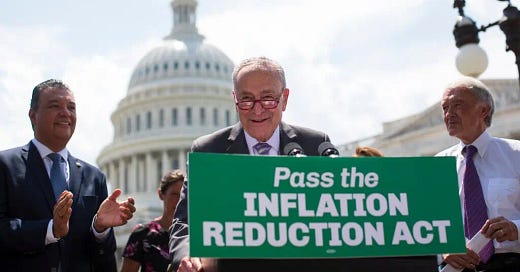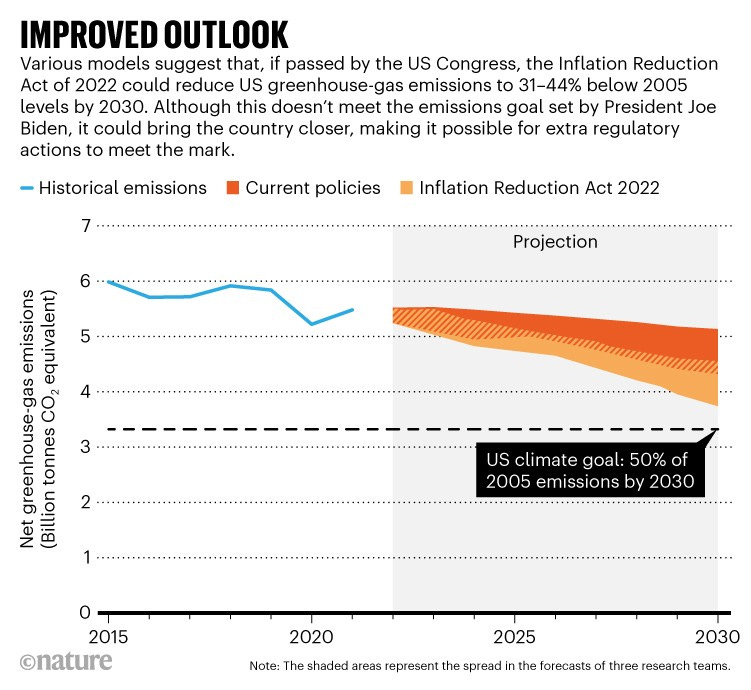The Weekly Anthropocene, August 10 2022
Dispatches from the Wild, Weird World of Humanity and its Biosphere.
National Climate Action: United States
For decades, the United States Senate has been the graveyard for climate action. (For the full history, check out this footnote).1 As recently as mid-July, it appeared that nothing could pass in Biden’s first term, with longtime coal industry investor Senator Joe Manchin (D-WV) seemingly implacably opposed and the Democrats’ room for maneuver nonexistent in a 50-50 Senate with the majority only conferred by Vice President Harris’ tie-breaking vote.
And then, a political miracle occurred. In a matter of weeks, the Democrats announced a new deal that Manchin had agreed to, with $306 billion for deficit reduction, $64 billion for healthcare, and $369 billion on clean energy and climate provisions. They dubbed it the Inflation Reduction Act, and made some more tweaks to mollify their other recalcitrant senator, Kyrsten Sinema (D-AZ), mostly by not raising taxes on private equity, plus some extra drought funding for Arizona.
And on Sunday, August 7th, it passed the United States Senate, on a party-line vote of 51-50. It passed. It passed. IT PASSED! (Pictured above: Democratic Senate Majority Leader Chuck Schumer, D-NY). America has been waiting for longer than this writer’s lifetime for the Senate to pass a climate bill of this transformative magnitude, and some said it could never be done. It’s not quite a done deal yet, but it’s 95% of the way there-the House is set to vote on it on August 12th, and the Democrats have a strong majority there with all major blocs supporting the bill. President Biden is incredibly eager to sign it into law.
It is hard to overstate just how good this news is. It’s the difference between a patchwork of state-level action, executive order, and private industry trying to do America’s part in the fight against climate change for the next decade, and a concerted whole-of-government push to lead the world in the renewables revolution. According to early modeling (pictured, above), the Inflation Reduction Act investments alone should reduce US greenhouse gas emissions by around 40% below 2005 levels by 2030, making Biden’s goal of 50% below 2005 levels by 2030 within reach.
There's just so much money in this bill, for every good emissions-reducing technology around. Here’s a sample (and here’s a full list): $8.8 billion in rebates for home electrification and retrofitting, $27 billion for a Greenhouse Gas Reduction Fund that would serve as a “green bank” offering low-cost financing to community renewables projects, $40 billion for the Department of Energy’s already highly successful Loan Programs Office to get more grid-scale renewables projects off the ground, $1.8 billion for wildfire risk reduction, $3 billion for neighborhood-level environment grants, $9.7 to the USDA for clean rural electric systems, $2 billion through 2031 in grants for domestic clean vehicle manufacturing, $20 billion for climate smart agriculture from conservation easements through soil carbon storage, a new $5.8 billion program to fund projects to decarbonize high-emitting industries like ceramics, paper, and concrete, $10 billion in an extended tax credit for renewables, and much, much more. Oh, and a world-first fee charging oil and gas companies up to $1,500 a ton for methane leaks from their facilities, creating a key incentive to reduce a potent greenhouse gas. Plus, a study found that its renewables investments, and consequent reduction of fossil fuel burning and air pollution will likely prevent 3,894 premature deaths per year by 2030. And keep in mind that all of this benefits clean energy progress in the rest of the world as well, by creating strong economic incentives for research, development, and commercialization of new and better renewables and other emissions-reducing technologies and methods.
The bill isn’t 100% perfect: it also includes considerable funding to help fossil fuel companies develop carbon capture technology, which has historically been essentially a giveaway to fossil fuel companies without reducing emissions. Manchin also negotiated a “side deal” for future Democratic support of another bill which would make it easier to build new energy projects without environmental review, and specifically move forward a natural gas pipeline in West Virginia. Still, that’s the price of Manchin’s support, and it’s not doing much harm. Making it easier to build new energy projects might well end up benefiting clean energy projects more than fossil fuels, these days!
Frankly, if this gets signed into law (as now appears overwhelmingly probable-not passing the House at this point would be a screwup of the highest order), Biden and the current Democratic-majority Senate and House deserve to go down in history as one of the most successful President-Congress teams since FDR. They succeeded where Clinton and Obama failed, and where Bush and Trump didn’t even try, in mustering a response to the planetary-level threat of climate change that is actually appropriate to the scale of the problem. The next decade is going to see truly extraordinary clean energy progress. And America will have truly fulfilled its promise to the world to lead on the issues that matter. Truly spectacular news!
National Climate Action: India
The government of India issued a new formal update of their nation’s Nationally Determined Contribution, the Paris Agreement climate plan formalizing their emissions reduction targets. India is now pledging to reach net zero greenhouse gas emissions by 2070, reduce emissions intensity (amount of GHG emissions per unit of GDP) by 45% below 2005 levels by 2030, and get 50% of installed electricity generation capacity from non-fossil fuel sources (renewables, hydro, and nuclear) by 2030, up from around 40% today.
National Climate Action: Australia
In the wake of the May 2022 election victory of Labor, the Greens, and pro-climate action independents (covered in this newsletter), Australia is close to passing a major climate bill of its own. The lower house of the Australian Parliament voted on August 4th in favor of a bill to legally require Australia to reduce its carbon emissions 43% below 2005 levels by 2030, and it’s set to pass the Senate and be signed into law in September, with a majority already in favor!
Switzerland
In July 2022, Nant de Drance, a gigantic new pumped hydro storage facility or “water battery” began operations in the mountains of the Valais canton of Switzerland. The new facility connects two preexisting reservoirs, one higher than the other, with six water-pumping turbines moving water up from the lower reservoir to the higher one when there’s excess energy floating around the Swiss grid, and letting water flow down through them from the higher to the lower to generate extra energy when needed. The turbines are stored in a cavern the length of two US football fields, and when in their “withdrawing energy” phase are powered by water falling through a steel pipe taller than the Eiffel Tower. The immense system also contains 17 kilometers of underground service galleries. (Video above shows a construction time-lapse, the two reservoirs are pictured above, more info here). This is a great new asset for Switzerland, and a perfect example of the kind of clever energy storage projects that perfectly complement renewables!
Wild World: Japan
A new species of sea anemone has been discovered in Suruga Bay, Japan, and formally described for science in a newly published study. It lives exclusively on the shell of one species of hermit crab, Pagurodofleinia doederleini, in what is likely an “obligate symbiotic” relationship, and grows to cover the entire area of the shell (pictured, above). Fascinatingly, video observations of the two species have found that when the hermit crab moves to a new shell, it spends over 40 hours peeling the anemone off the old shell, dragging it to the new shell, and reinstalling it on top. This profound time and energy expenditure strongly indicates that the anemone and crab are providing substantial benefits to each other: the crab moves the anemone through new feeding grounds and the anemone protects the crab from parasites and predators with its stinging tentacles. The new sea anemone species has been given the scientific name of Stylobates calcifer, named after a character from the Howl’s Moving Castle franchise in a nod to its “moving castle”-like nature. An awesome discovery!
Wild World: Malawi
Wildlife officials undertook a gargantuan task in the small African nation of Malawi in July 2022: moving 263 elephants from Liwonde National Park to Kasungu National Park. Before this translocation, Liwonde was home to 600 elephants, more than its local ecosystem could support. Elephants were starting to raid local farmers’ crops for food, creating conflict. Kasungu is larger, covering 2,100 square kilometers (810 square miles) compared to Liwonde’s 548 square kilometers, but it was home to only 120 elephants, having been devastated by poachers in recent decades and only starting to recover under a better protection regime starting in 2017. The 263 new arrivals were sedated and transported by truck (pictured and in video, above). They now have more room to roam in their new home, and their absence in Liwonde is making elephant neighbors easier to live with for the local people at the same time. Another great example of proactive conservation fit for the complex human/animal mosaic of the Anthropocene!
In 1988, climate change first gained broad attention in US politics when NASA scientist James Hansen testified about the greenhouse effect before the Senate. They made no policy changes in response. In 1993, President Bill Clinton attempted to pass an energy tax on essentially all forms of energy except wind, solar, and geothermal to incentivize more energy conservation and renewable energy use. It stalled in the Senate. In 1997 and 1998, the Clinton Administration supported and signed the Kyoto Protocol, an early attempt at an international emissions-reducing climate change treaty, but the US never ratified it because it couldn’t pass the Senate. In 2009, with a brand new Democratic majority, President Obama tried to pass the Waxman-Markey cap-and-trade bill, which would have established a market-based emissions reduction framework. This was based on the cap-and-trade system for acid rain-causing sulfur-dioxide emissions established by the 1990 Clean Air Amendments (which were spectacularly successful). It passed the House, but died in the Senate. In 2021, President Joe Biden tried to pass the Build Back Better Act, a $2.2 trillion mega-bill that would have created universal preschool, paid family leave, and a year of expanded child tax credits along with $555 billion in clean energy and climate provisions. It passed the House in November 2021, but died in the Senate when Joe Manchin said he wouldn’t vote for it.
We have, to be fair, gotten some federal climate action, mostly attached to other bills. The best and most impactful example was the $90 billion for clean energy in the highly successful American Recovery and Reinvestment Act, the Obama-led stimulus bill of 2009 which essentially made possible the booming clean energy industry America has today. But we need way more-and (see article above) we’re about to get it!








